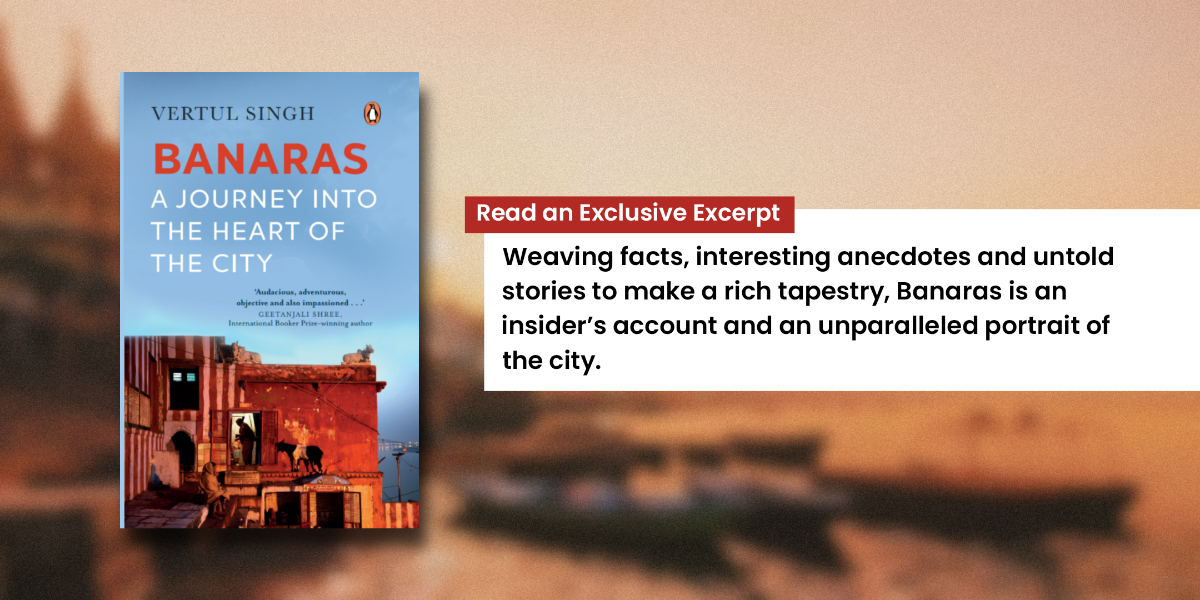Uncover the timeless charm of Banaras with Vertul Singh. From its sacred ghats and vibrant temples to its rich history and culture, Singh’s vivid storytelling paints an unforgettable portrait of Banaras, making it a must-read for anyone seeking the soul of India. Read this exclusive excerpt and embark on a journey through the heart of Banaras today!

***
The crescent-shaped layout of Banaras city on the western banks of the river Ganga is truly unique in the world. It stretches from the Samne ghat in the south to Namo ghat in the north—a total of eighty-four ghats over a linear distance of about 6.4 km. The original city was on the northern side on the elevated plateau of Rajghat, near the Varuna–Rajghat confluence, which served as the hub for the ancient river trade. The city’s expansion towards the southwestern side started with its growing importance as a pilgrimage site. Alongside the sacred kunds, the ghats gained prominence, too, for religious ablutions and sacramental rites. These ghats are the cultural and religious identity of Kashi. Built mainly from sandstone, sourced from the Chunar quarry in the nearby Mirzapur, each ghat has a history and a purpose. Every ritual performed on a ghat is followed by merry-making and indulgence. This sensualist aspect of Hinduism is what makes Banaras a city pulsating with life. A disjunction between the sombre and existentialist questions of the great crematorium and the epicurean delights it lays out. It is here that the difference between Shiva, the lord, and Shav, the corpse, is completely wiped out. The ghats are the spiritual and cultural ambience of the city, and the centre of traditional scriptural erudition. They are not just structures but the muse of the city—the very soul of the city is encapsulated here. The holy Ganga, flowing in a crescent shape, lends its shape to the layout of these ghats. For some reason, though, Ghalib, in his Masnavi, has compared the beauty of Banaras with China to describe the crescent shape of the Ganga.
Someone once compared the beauty
of Banaras to China,
And since that day its brow is wrinkled
With the bend of the Ganga
Most of the important Hindu temples are located along these ghats. These sonatas set in stone are of recent origin, when we consider the antiquity of this city.
It is irresistible for me to not quote James Prinsep here. When it comes to his description of the ghats of Banaras, he is more of a poet than a member of the Viceroys’ government. In a letter to his sister, he described his first tryst with Banaras as:
This is glorious sight to see the ghats of Benares covered with a moving sea of heads, studded at small distances with temples of red and white stone, all minutely covered and adorned with flowers, while from a hundred places, cymbals and drums peel forth their strains of adoration. The time too is generally favourable to the exhibition, namely, at an eclipse of the sun or at the rising of the full moon. As soon as the signal is given by Brahmins, plunge all the bathers and ripple the holy waters for a mile and a half along the shore.
These ghats, over the years, may have undergone a change of name, although travellers like Ralph Fitch and Jean-Baptiste Tavernier were not able to pinpoint and name these obscure ghats. All the same, in the medieval literature on Kashi, a few unfamiliar names of the ghats do appear. This aspect is important for tracing the changing paradigm of Hinduism, whenever it was threatened. This has mostly happened in the last 300 years. During the British Raj, every Hindu ruler wanted to have a slice of this sanctum pilgrimage pie, by purchasing and renaming a ghat or two after his dynasty or the name of his principality. Even the Muslim rulers, most notably Aurangzeb, attempted and were largely successful, in altering the skyline of the sacred crescent ridge of Banaras forever. Thus, we now have ghats that are named Scindia, Darbhanga, Panchkote, Mysore, Vizianagaram, etc. However, the two most prominent and important ghats for Hindus remain the Dashashwamedha ghat and the Manikarnika ghat, both of which record a heavy pilgrim footfall throughout the year. These two most ancient ghats have also been the places where most of the Puranic stories on Kashi are set. Based on lores, particularly in the Kashi Khand, five such ancient ghats are noteworthy: the Asisamved teerth on the Asi–Ganga confluence, the Varuna–Ganga confluence as described in the Linga Purana, the Dashashwamedha ghat, the Panchnanda ghat or the Dharmnad, at the confluence called of five mythical rivers: Ganga, Yamuna, Saraswati, Kirna and Dhootpapa. At Panchnad and at Varuna–Ganga confluence ‘the Padoka’, it is important to note that Vishnu is the chief pilgrimage deity. The last ancient one being the Manikarnika, we have already mentioned about the well that was filled with the sweat of Vishnu.
***
Get your copy of Banaras by Vertul Singh on Amazon or wherever books are sold.







